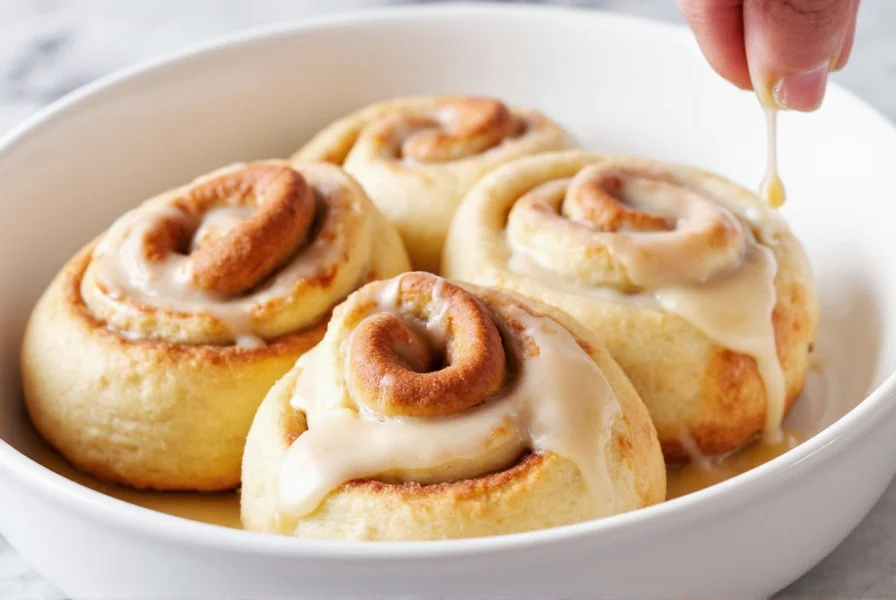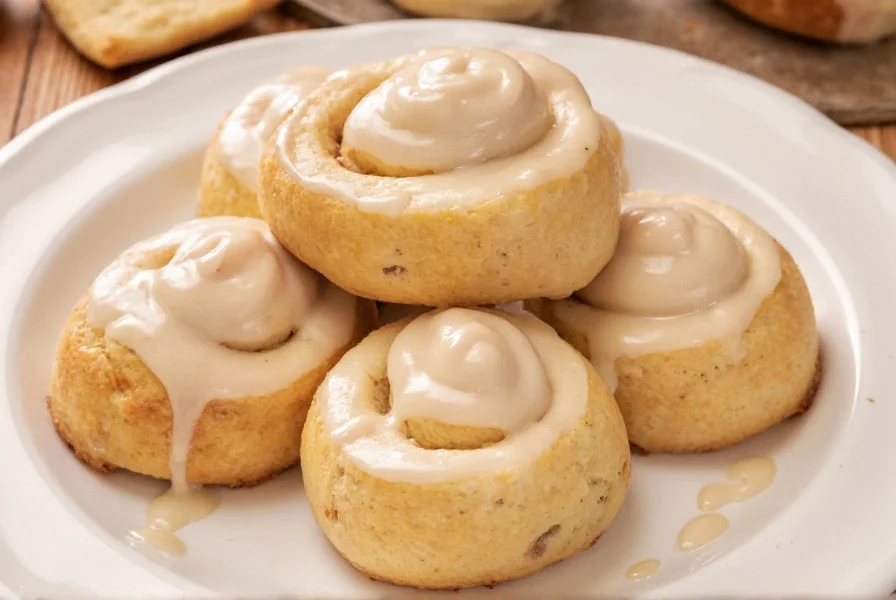When crafting the perfect icing for cinnamon scrolls, understanding the delicate balance between sweetness, texture, and flavor compatibility is essential. Unlike standard cake frosting, cinnamon scroll icing must complement the warm spices in the dough while providing just enough sweetness to enhance—but not dominate—the overall flavor profile. The ideal icing should be thick enough to cling to the warm pastry without immediately soaking in, yet soft enough to spread smoothly across the surface.
Why Cream Cheese Icing Reigns Supreme
Cream cheese icing remains the gold standard for cinnamon scrolls for compelling reasons. Its slight tang cuts through the richness of the buttery pastry, creating a more complex flavor experience than plain powdered sugar glazes. The fat content in cream cheese provides a luxurious mouthfeel that standard confectioners' sugar icing lacks, while its natural acidity balances the intense sweetness of the cinnamon filling.
Professional bakers consistently choose cream cheese frosting for cinnamon scrolls because it maintains structural integrity at room temperature better than many alternatives. Unlike thinner glazes that can soak into the pastry and make it soggy, properly prepared cream cheese icing forms a delicate crust on top while keeping the interior soft—a critical quality for the best icing for cinnamon rolls.
Perfect Cream Cheese Icing Recipe
This tested recipe yields enough icing for 12 standard cinnamon scrolls with perfect consistency every time:
| Ingredient | Measurement | Preparation Tip |
|---|---|---|
| Cream cheese | 4 oz (full-fat block) | Room temperature, not spreadable |
| Unsalted butter | 1/4 cup | Room temperature |
| Powdered sugar | 1 cup | Sifted, not packed |
| Vanilla extract | 1/2 tsp | Pure extract preferred |
| Salt | Pinch | Enhances flavor complexity |
Instructions: Beat cream cheese and butter together until completely smooth (2-3 minutes). Gradually add sifted powdered sugar while mixing on low speed. Add vanilla and salt, then beat on medium-high for 1 minute until light and fluffy. If too thick, add 1 tsp milk; if too thin, add more powdered sugar 1 tablespoon at a time.
Alternative Icing Options Worth Trying
While cream cheese reigns supreme, these variations offer distinctive flavor profiles for different preferences:
- Vanilla Glaze: For those preferring a lighter topping, combine 1 cup powdered sugar with 2-3 tbsp milk and 1 tsp vanilla. This how to make cinnamon roll glaze option works well when you want the cinnamon flavor to shine through without competition.
- Brown Sugar Buttercream: Substitute half the powdered sugar with dark brown sugar for a caramel-like depth that enhances the cinnamon notes.
- Lemon-Infused Icing: Add 1 tbsp fresh lemon zest to the cream cheese base for a bright counterpoint to the warm spices.
Timing Is Everything: When to Apply Icing
The perfect moment to apply icing significantly impacts the final result. Contrary to popular belief, applying icing to piping hot cinnamon scrolls creates several problems:
- Melts the icing, causing it to soak completely into the pastry
- Dilutes the icing's flavor as it absorbs into the dough
- Creates an unpleasantly soggy texture throughout the roll
For optimal results with your homemade cinnamon roll frosting, wait until the scrolls have cooled for 10-15 minutes after baking. They should still be warm to the touch (about 110°F/43°C) but not hot enough to melt the icing immediately. This allows the icing to set partially on the surface while still absorbing just enough warmth to become delightfully creamy.
Troubleshooting Common Icing Problems
Even experienced bakers encounter icing issues. Here's how to fix the most frequent problems with perfect icing consistency for cinnamon buns:
| Problem | Immediate Fix | Prevention for Next Time |
|---|---|---|
| Icing too runny | Add powdered sugar 1 tbsp at a time | Use cold cream cheese, not room temperature |
| Icing too thick | Add milk 1 tsp at a time | Measure powdered sugar carefully; don't pack |
| Icing separates | Add 1 tsp cornstarch while mixing | Ensure all ingredients at room temperature |
| Icing too sweet | Add pinch of salt or lemon juice | Reduce sugar by 2 tbsp; add cream cheese |

Flavor Pairing Principles for Cinnamon Scrolls
The magic of exceptional cinnamon scroll icing lies in understanding flavor chemistry. Cinnamon contains cinnamaldehyde, which creates its distinctive warm, spicy-sweet profile. The ideal icing enhances this compound without overwhelming it.
Professional pastry chefs recommend maintaining a 3:1 ratio of sweetness to tang when creating cinnamon scroll icing. This means for every 3 parts sweet element (powdered sugar), include 1 part tangy element (cream cheese or citrus). This ratio creates what food scientists call "flavor layering"—where each component remains distinct yet harmonious.
For those experimenting with cinnamon scroll icing troubleshooting, remember that temperature affects perceived sweetness. Icing applied to warm scrolls will taste sweeter than the same icing on cooled pastries, so adjust your recipe accordingly based on when you plan to serve them.
Storage Considerations for Iced Cinnamon Scrolls
Proper storage maintains both pastry and icing quality. Cream cheese-iced scrolls should be stored at room temperature for up to 24 hours or refrigerated for 3-4 days. When refrigerating, place parchment paper between layers to prevent sticking.
Reviving day-old iced cinnamon scrolls: Warm briefly (10-15 seconds in microwave) to soften the icing, then let sit for 2 minutes to allow the icing to re-set slightly. This restores the fresh-baked experience while maintaining the perfect icing consistency for cinnamon buns.
Frequently Asked Questions
Can I use low-fat cream cheese for cinnamon scroll icing?
While possible, low-fat cream cheese produces inferior results for the best icing for cinnamon rolls. The reduced fat content creates a thinner, less stable icing that lacks the rich mouthfeel of full-fat versions. For optimal texture and flavor balance, always use regular block cream cheese at room temperature.
Why does my cream cheese icing become grainy?
Grainy texture in cream cheese icing typically occurs when the cream cheese isn't fully softened before mixing or when powdered sugar isn't sifted. Ensure your cream cheese is at proper room temperature (not warm) and always sift powdered sugar to eliminate lumps. Beat the cream cheese and butter thoroughly before adding sugar for smoothest results.
How can I make my cinnamon roll glaze set firmer?
To achieve a firmer set for your how to make cinnamon roll glaze, reduce liquid content by 1-2 teaspoons and increase powdered sugar by 2-3 tablespoons. For professional results, add 1/4 teaspoon cornstarch to the dry ingredients before mixing. Allow iced scrolls to rest for 30 minutes at room temperature for optimal setting before serving.
Can I prepare cinnamon scroll icing ahead of time?
Yes, you can prepare cream cheese icing up to 24 hours in advance. Store in an airtight container with plastic wrap pressed directly against the surface to prevent crusting. Before using, beat briefly to restore smooth texture. Note that refrigerated icing will need 30-60 minutes at room temperature to reach proper spreading consistency for cinnamon scrolls.
What's the difference between icing and frosting for cinnamon rolls?
The terms are often used interchangeably, but technically, icing refers to thinner, sugar-based mixtures that harden as they dry, while frosting indicates thicker, cream-based mixtures like cream cheese that remain soft. For cinnamon scrolls, 'frosting' is more accurate for cream cheese varieties, while 'glaze' describes thinner powdered sugar mixtures. The best choice depends on your desired texture and flavor profile.











 浙公网安备
33010002000092号
浙公网安备
33010002000092号 浙B2-20120091-4
浙B2-20120091-4